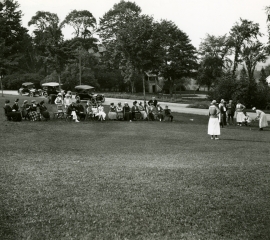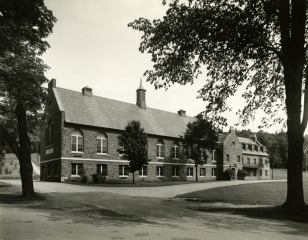as to the date was uncertain. By student request, military drill and calisthenics were instituted in November, 1942, to promote physical fitness when the call should come. The program continued until civilian enrollment in early 1943 became too small to maintain it.
Because of the accelerated academic schedule, the Class of 1943 graduated December 13, 1942. Wartime travel difficulties failed to keep parents and relatives from coming in great numbers to see 184 seniors take their degrees. The consciousness that most of them would soon be in service and some would never be back made this “White Commencement” probably the most poignant in Colgate’s history. Later commencements were held at the end of each term, some with so few seniors present that the exercises took place in the library of the President’s House.
Meanwhile, the new president had been active in Washington trying to convince appropriate officials of the University’s qualifications for training naval cadets. In December he could report that Colgate had been asked to become one of 20 colleges to establish a Naval Flight Preparatory School on January 7, 1943. Six hundred cadets would be assigned to the campus to take a three-months course in the study of aircraft and an intensive program of physical training prior to going on to flying school. From this date forward a large proportion of the University’s instruction and facilities were to be devoted to the use of the Navy for this program and others to follow. Lt. Commander E. Trudeau Thomas, headmaster of a boys preparatory school in Pennsylvania, was officer in charge of the unit and Dr. Sidney J. French, coordinator for the college. The unit was always at or near the top position in scores on uniform tests administered to all Naval Flight Preparatory Schools. This record is noteworthy when it is remembered that most of the Colgate faculty, unlike instructors at the engineering colleges in the program, had only limited backgrounds for teaching such subjects as navigation, mathematics and physics. They successfully “re-tooled” and met a demanding assignment. The cadets lived in the dormitories and were fed in the Student Union which was also headquarters for the Unit. When the program was discontinued in September 1944 its enrollment had totaled 2808.
The excellent records established by the War Training Service and the Naval Flight Preparatory School programs, and the cordial relations between Colgate and Navy personnel favored establishing a third







